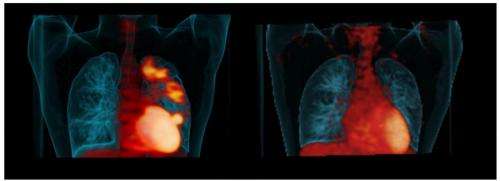The image on the left shows 'hot spots' of infection in a patient's lungs before treatment. The image on the right shows the disease improvement after six months of taking the drug linezolid. Credit: University of Pittsburgh
Sophisticated lung imaging can show whether or not a treatment drug is able to clear tuberculosis (TB) lung infection in human and macaque studies, according to researchers at the University of Pittsburgh School of Medicine and their international collaborators.
The findings, published online today in Science Translational Medicine, indicate the animal model can correctly predict which experimental agents have the best chance for success in human trials.
The image on the left shows "hot spots" of infection in a patient's lungs before treatment. The image on the right shows the disease improvement after six months of taking the drug linezolid.
In 2012, an estimated 8.6 million people in the world contracted TB, for which the first-line treatment demands taking four different drugs for six to eight months to get a durable cure, explained senior investigator JoAnne L. Flynn, Ph.D., professor of microbiology and molecular genetics, Pitt School of Medicine. Patients who aren't cured of the infection - about 500,000 annually - can develop multi-drug resistant TB, and have to take as many as six drugs for two years.
"Some of those people don't get cured, either, and develop what we call extensively drug-resistant, or XDR, TB, which has a very poor prognosis," she said.
"Our challenge is to find more effective treatments that work in a shorter time period, but the standard preclinical models for testing new drugs have occasionally led to contradictory results when they are evaluated in human trials."
In previous research, Dr. Flynn's colleagues at the National Institutes of Health found that the drug linezolid effectively treated XDR-TB patients who had not improved with conventional treatment, even though mouse studies suggested it would have no impact on the disease.
To further examine the effects of linezolid and another drug of the same class, Dr. Flynn and her NIH collaborators, led by Clifton E. Barry III, PH.D., performed PET/CT scans in TB-infected humans and macaques, which also get lesions known as granulomas in the lungs. In a PET scan, a tiny amount of a radioactive probe is injected into the blood that gets picked up by metabolically active cells, leaving a "hot spot" on the image.
The researchers found that humans and macaques had very similar disease profiles, and that both groups had hot spots of TB in the lungs that in most cases improved after drug treatment. CT scans, which show anatomical detail of the lungs, also indicated post-treatment improvement. One patient had a hot spot that got worse, and further testing revealed his TB strain was resistant to linezolid.
The findings show that a macaque model and PET scanning can better predict which drugs are likely to be effective in clinical trials, and that could help get new treatments to patients faster, Dr. Flynn said. The scans also could be useful as a way of confirming drug resistance, but aren't likely to be implemented routinely.
"We plan to use this PET scanning strategy to determine why some lesions don't respond to certain drugs, and to test candidate anti-TB agents," she said. "This might give us a way of tailoring treatment to individuals."
More information: "PET/CT imaging correlates with treatment outcome in patients with multidrug-resistant tuberculosis," by R.Y. Chen et al. stm.sciencemag.org/lookup/doi/ … scitranslmed.3009501
Related:
MT Coleman et al. PET/CT imaging reveals a therapeutic response to oxazolidinones in macaques and humans with tuberculosis. Science Translational Medicine DOI:10.1126/scitranslmed.3009500 (2014).
Journal information: Science Translational Medicine





















